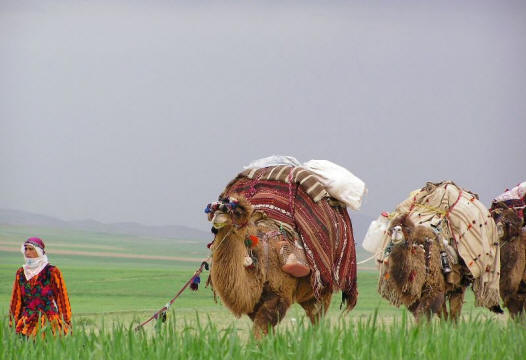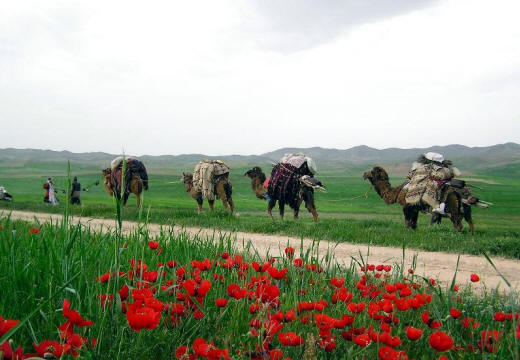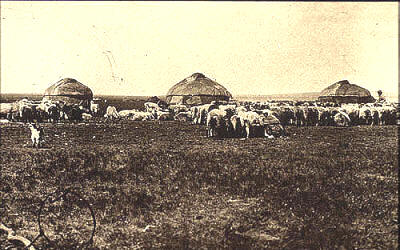
| SAKA AND IRAN - SHAHR'S Love-Hate Relationship Between the Autonomous Saka and Iran-Shahr's Overlords :
Northern Khorasani nomads. Image Credit: Khoosheh-Chin
Northern Khorasani nomads. Khorasan is modern Parthava (Parthia). Note poppies. Image Credit: Khoosheh-Chin While some Saka became part of the Iranian-Aryan mainstream and a part of the Iranian-Aryan federation of nations, others choose to stay as autonomous as possible. Those Saka who became part of the Iranian mainstream, themselves had problems with the Saka who chose to stay autonomous. Regardless of their autonomy, when Ira-Shahr was threatened by external forces, it was often the Saka who came to the rescue. The relationship between the autonomous Saka and with those Saka who chose to remain in the Iranian federation as well as with the overlords of the Iranian federation, the king-of-kings or emperor, as well as the relationship between the settled Aryan peoples and the predatory or nomadic groups, can best be described as a love-hate relationship.
On the one hand, the Saka gave sanctuary and protection to Persians fleeing Alexander's army, and helped free Sughdha and Bakhdhi from the regime left behind by Alexander.
On the other hand, Achaemenian Persian Emperor Cyrus the Great and two Saka Parthava (Parthian) kings of Iran-Shahr, Frahata (Phraates) II, (c.138-127 BCE) and Ardaban (Artabanus) I (c.127-124 BCE) lost their lives in quick succession battling the Saka. Amongst the Parthian kings, the former perished at the hands of Saka in his army who revolted demanding more pay, while the latter died attacking the Tochari Saka who inhabited some areas north of the Kopet Dag mountains - mountains that today form the border between Iran and Turkmenistan. To add confusion to the story.
If we had a third hand, we would say that on yet another hand, the former Parthian Ardaban's successor, Ardaban (Artabanus) II was supported by a strong army of Dahae Saka (see below) in putting down a revolt.
The reader will appreciate why we describe the relationship as that of family members who alternate between loving and hating one another. When hate took over, they were not beyond killing one-another. This relationship is typified in legend between the kings of the Iranian-Aryan land of Sistan, Sam and Rustam, and the king-of-kings, the emperors of the Iranian-Aryan lands, to Sistan's north - Balkh (Bakhdhi). Sam and Rustam were pahlavans, champions of Iran, a name shared by the Parthians.
Herds-People / Nomadic Aryans :
Central Asian nomadic encampment with yurts and sheep. Note the sparse grass That groups employed in nomadic herding were also part of the Aryan family is indicated by Herodotus in 1.125. Here, he divides the Persian tribes that supported Cyrus into the settled and nomadic tribes: "The Persian nation contains a number of tribes, and the ones which Cyrus assembled and persuaded to revolt were the Pasargadae, Maraphii, and Maspii, upon which all the other tribes are dependent. Of these, the Pasargadae are the most distinguished; they contain the clan of the Achaemenids from which spring the Perseid kings. Other tribes are the Panthialaei, Derusiaei, Jermanii, all of which are attached to the soil, the remainder - the Dai, Mardi, Dropici, Sagarti, being nomadic." (Translation by Aubrey de Selincourt)
It stands to reason, that people living in arid lands or mountain valleys not suitable for agriculture, would breed herds of cattle, sheep and horses instead. These people would have to move constantly in order find fresh pastures for their herds. However, their kinfolk who lived beside rivers in lands suitable for agriculture, would need to stay in one place and build settlements.
In 11.13.6, Strabo states, "Nearchus says that there were four predatory tribes and that of these the Mardi were situated next to the Persians... ." Here Strabo equates the nomadic Mardi mentioned by Herodotus as a predatory tribe as well. Nevertheless, we should equate nomadic with been predatory. Nomads were not necessarily predatory.
When Herodotus describes the five tribes (Busae, the Paretaceni, the Struchates, the Arizanti, the Budii, and the Magi) of the Medes in 1.101, we find that the Medes and by extension the Aryans, consisted of the Magi, civil, nomadic and predatory groups. Presumably, the settled and nomadic Iranian-Aryans were not just neighbours - they were in all likelihood intermingled communities living side-by-side. That phenomenon can be observed in Iran and central Asia even today. An example are the cave-dwelling residents of Maymand, Kerman in Central Iran, they would have moved with their herds during the summer but returned to permanent homes during the winter - living therefore a fusion of nomadic and settled lives.
Inevitably, the two groups, the nomadic and the settled, would have developed different values, and their societies can therefore expected to have come into conflict from time to time.
Predatory Aryans Living Amongst Civil Aryans
Strabo calls the Paraetaceni, a predatory tribe. In 11.13.6 he states: Greater Media is bounded on the east by Parthia and the mountains of the Cossaei (Kassite, today's Bakhtiari region), another predatory people, who once supplied the Elymaei (Elamites), with whom they were allies in the war against the Susians and Babylonians, with thirteen thousand bowmen. Nearchus says that there were four predatory tribes and that of these the Mardi were situated next to the Persians; the Uxii and Elymaei next to the Mardi and the Susians; and the Cossaei next to the Medians; and that whereas all four exacted tribute from the kings (ransom in reverse*), the Cossaei also received gifts at the times when the king, after spending the summer in Ecbatana, went down into Babylonia; but that Alexander put an end to their great audacity when he attacked them in the winter time. So then, Greater Media is bounded on the east by these (predatory) tribes, and also by the Paraetaceni, who border on the Persians and are themselves likewise mountaineers and predatory... .
*That these predatory tribes were able to exact tribute from the imperial government that surrounded them is a reversal in roles, since vassal states normally paid tribute to the dominant kingdom of the empire. Strabo in 11.13.6, and Diodorus Siculus (1st cent. BCE) in 19.19.2-3, add that the Cossaea/Kassites collected tolls for road passage on the route between Ecbatana and Mesopotamia and the mountain shortcut from Susiana to Ecbatana!
Herodotus states that the Paraetaceni were a Median clan. In 1.101, he states that the Medes consisted of "the Busae, the Paretaceni, the Struchates, the Aryzanti, the Budii, and the Magi." Further, in 7.62, Herodotus states, "These Medes were called anciently by all people Aryans." The name Ary-zanti may also indicate Aryan descent. If the Paretaceni are a tribe of the Medes and if the Medes were Aryans, then it follows that the Paretaceni were also Aryans. Paraetaceni may be broken down to Parae-tak-(eni) giving us Paraetak as the Iranian name.
According to Arrian in Anabasis 3.19.2, Diodorus Siculus at 19.34.7, the land of the Parataceni (Paraetacae), that is, Paraetacena (cf. Ptolemy, 6.4.3), occupied the mountains of western and northern Persia. The Parataceni held the shorter but more mountainous road from Persia into Media. Compared to the Cossaea and the other Saka or Saka-like tribes, the Parataceni were more settled and practiced farming.
Strabo in 15.2.14 states that Carmania (Kerman) has a desert which extends to Parthia and to Paraetacena.
Pliny in 6.29.113 sees Persian Paraetacena as extending eastward between Parthia (Khorasan) and Carmania (Kerman), an area either bordering on or including Sistan. Isidorus in 18 introduces us to the land of the Saka which had moved to Sistan (Sakastan) by his time. That land included the Paraetacena: "Beyond is Sacastana of the Scythian Sacae (Saka), which is also Paraetacena, 63 schoeni (378-508 km) [a comparatively large district]. There are the city of Barda and the city of Min and the city of Palacenti and the city of Sigal; in that place is the royal residence of the Sacae." We are not sure if we can read into this account by Isidorus, that the Paraetacena were simply living amongst the Saka or were a Saka people.
The geographical location for the Paraetacena given by Strabo, Arrian and Diodorus, is east of Media and Persia, i.e., the mountainous areas of Isfahan, Yazd and Kerman. However, the accounts of Pliny and Isidorus place the Paraetacena further east and cross the great deserts of the Iranian plateau arriving at the mountains of Sistan, Khorasan and Afghanistan (which would imply that Media and Persia stretched all the way east to these mountains). Arrian in Anabasis in 4.22.1 moves the Paraetacena even further east - as far east as the mountainous area in eastern Sogdiana and appears to use the name for all predatory Saka who lived in the mountains of the Iranian plateau.
While we have included a discussion on the Paraetacena in this page on the Saka, and while some may believe the Paraetacena model stereotype Saka behaviour, at this point we do not find a strong connection between the Paraetacena and the Saka.
Predatory Saka :
Strabo 11.8.4: "The Sacae, however, made raids like those of Cimmerians and Treres, some into regions close to their own country, others into regions farther away. For instance, they occupied Bactriana, and acquired possession of the best land in Armenia, which they left named after themselves, Sacasene (cf. Sacasan / Sakastan); and they advanced as far as the country of the Cappadocians, particularly those situated close to the Euxine, who are now called the Pontici. But when they were holding a general festival and enjoying their booty, they were attacked by night by the Persian generals who were then in that region and utterly wiped out."
[The Saka (and the other Aryans as well) travelled far from the original eastern lands, naming some of the lands they settled after them. In talking about Sacasene, Strabo could well be taking about Sakastan (derived from Sakasan cf. Khorasan, and described on this page) that later became Sistan, the home of Rustam, pahlavan and protector of the Iranian throne - allied but autonomous, and fiercely independent when so inclined.]
Source :
http://www.heritageinstitute.com/ |


